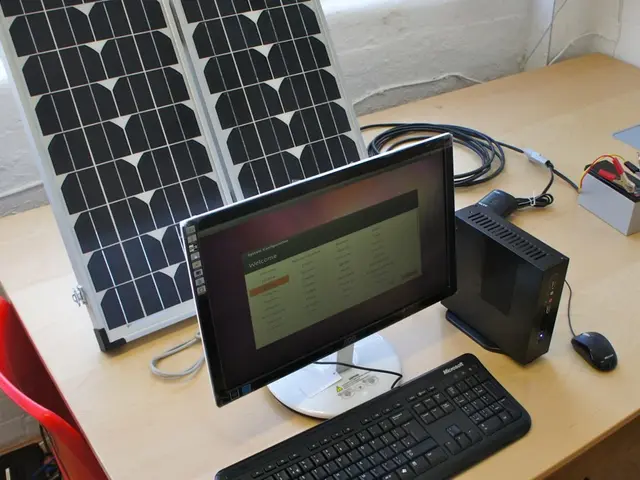Obtain Instant Downloads of ARC's Comprehensive Reports on Supply Chain Market Insights
=====================================================================
In the ever-evolving world of logistics, digital freight marketplaces are redefining agility, and the latest market research from ARC is providing valuable insights into this transformative landscape.
The research encompasses a wide range of topics, including the analysis of Supplier Ecosystems and Competitive Benchmarking, Strategic Priorities and Innovation Drivers, and the exploration of various executive summaries, such as those focusing on Autonomous Mobile Robots (AMRs), Warehouse Management Systems (WMS), and Omni-channel Order Management Systems.
One of the most intriguing areas of focus is the growth of AMRs in warehouse automation. According to the research, the global AMR market for logistics and warehousing was valued at around USD 4.7 billion in 2024 and is projected to grow at a CAGR of about 18-19% through the next decade, reaching between USD 11.4 billion and USD 24.4 billion by the early 2030s. This growth is driven by factors such as the flexibility and cost-efficiency of AMRs, advances in AI, sensor, and navigation technologies, labor shortages, and the need for improved operational efficiency in warehouses.
AMRs significantly impact warehouse automation by enhancing inventory management, order fulfillment speeds, and overall workflow efficiency. They are capable of autonomous navigation using technologies like LiDAR and simultaneous localization and mapping (SLAM), reducing reliance on fixed infrastructure and human input, allowing for dynamic and scalable automation solutions. The increased use of AMRs in warehouses supports faster processing times, reduces human labor demands, and yields cost savings, making them especially valuable in response to labor shortages and the increasing complexity of supply chains.
From a market perspective, the supply chain for AMR components, such as sensors, batteries, and embedded systems, is predominantly sourced from advanced industrial nations like the U.S., Germany, Japan, and South Korea. This supply chain robustness supports AMR production scalability and rapid adoption in logistics hubs globally. The geographic focus includes Asia-Pacific, North America, and Europe, with Asia-Pacific expected to see particularly high growth rates in the logistics and warehousing sectors.
The COVID-19 pandemic initially constrained AMR growth due to supply chain disruptions and reduced investments, but the pandemic also highlighted the need for automation, accelerating AMR adoption after supply issues eased. Market competition involves key players such as Clearpath Robotics, Softbank Robotics, and others investing in innovation, expansion, and integration of AI to maintain competitive advantages.
Elsewhere in the research, Carrier management is discussed as part of Transportation Management Systems (TMS), Execution platforms are part of Transportation Execution Systems, and Cost control is part of TMS. The tech stack of Supply Chain Planning is evolving, with S&OP trends and smarter demand sensing trends being key areas of focus. System trends and market movers are part of WMS, and Automated Storage & Retrieval Systems (AS/RS) are another topic of interest.
Moreover, the research includes Primary Research (Technology Demos, Supplier Briefings, Customer Use Cases) and provides Actionable Insights to Future-Proof Your Roadmap and Identify Market Trends. It also addresses the navigation of an Ever-Changing Regulatory Environment and discusses Global Trade Management (GTM) Solutions and Global Trade Compliance (GTC) Systems. The control tower of modern fulfillment, Warehouse Management Systems (WMS), is another subject in the research. Lastly, Omni-channel Order Management Systems are discussed in one of the executive summaries.
In summary, the latest market research from ARC offers a comprehensive look at the current state and future trajectory of logistics, highlighting the transformative impact of technologies like AMRs on warehouse automation, and providing valuable insights for businesses looking to future-proof their strategies and stay ahead of the curve.
- The growth of Autonomous Mobile Robots (AMRs) in warehouse automation is a significant area of focus, driven by factors like cost-efficiency, technological advancements, labor shortages, and the need for improved operational efficiency in warehouses.
- The supply chain for AMR components, such as sensors, batteries, and embedded systems, is primarily sourced from advanced industrial nations like the U.S., Germany, Japan, and South Korea, supporting AMR production scalability and rapid adoption in logistics hubs globally.
- The research from ARC includes discussions on Carrier management, Execution platforms, and Cost control as part of Transportation Management Systems (TMS), addressing the navigation of an Ever-Changing Regulatory Environment and discussing Global Trade Management (GTM) Solutions and Global Trade Compliance (GTC) Systems.
- The tech stack of Supply Chain Planning is evolving, with S&OP trends and smarter demand sensing trends being key areas of focus, while System trends and market movers are part of Warehouse Management Systems (WMS), and Automated Storage & Retrieval Systems (AS/RS) are another topic of interest.
- From a business perspective, the latest market research from ARC provides Actionable Insights to Future-Proof Your Roadmap and Identify Market Trends, offering a comprehensive look at the current state and future trajectory of logistics, particularly in the technology, finance, and business industries.




